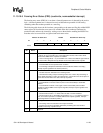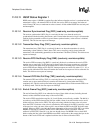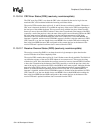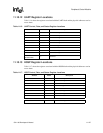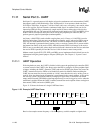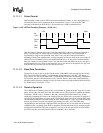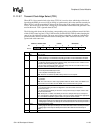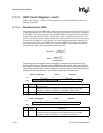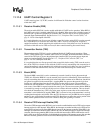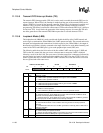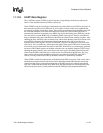
SA-1100 Developer’s Manual 11-131
Peripheral Control Module
removed from the receive FIFO without checking if more data is available. After this point, the
user must poll a set of status bits that indicates if any data remains in the receive FIFO or if space is
available in the transmit FIFO before emptying or filling the FIFOs any further.
11.11.1.6 CPU and DMA Register Access Sizes
Bit positioning, byte ordering, and addressing of the UART is described in terms of little endian
ordering. All UART registers are 8 bits wide and are located in the least significant byte of
individual words. The ARM
peripheral bus does not support byte or half-word operations. All
reads and writes of the UART by the CPU should be wordwide. Two separate dedicated DMA
requests exist for both the transmit and the receive FIFO. If the DMA controller is used to service
the transmit and/or receive FIFOs, the user must ensure the DMA is properly configured to perform
bytewide accesses, using 4 bytes per burst.
11.11.2 UART Register Definitions
There are seven bytewide registers within the UART: four control registers, one data register, and
two status registers. The control registers are used to program the baud rate, data length, number of
stop bits, and odd or even parity. They are used to receive and transmit sample clock edge type, and
to transmit a break. Also, they are used to enable or disable transmit and receive operation, parity,
use of the sample clock input, and loopback mode. The data register is 8 bits and addresses the top
location of the transmit FIFO and bottom location of the receive FIFO. When it is read, the receive
FIFO is accessed, and when it is written, the transmit FIFO is accessed. The status registers contain
bits that signal the transmit FIFO service request, receive FIFO service request, receiver idle, the
begin and end of break detect, and error in FIFO conditions. Each of these status conditions signal
an interrupt request to the interrupt controller. The status registers also flag when the UART is
actively transmitting characters, when the transmit FIFO is not full, when the receive FIFO is not
empty, and when a parity, framing, or overrun error was detected for the data value currently
located in the bottom entry of the receive FIFO (no interrupt generated).
11.11.3 UART Control Register 0
UART control register 0 (UTCR0) contains seven different bit fields that control various functions
within the UART.
11.11.3.1 Parity Enable (PE)
The parity enable (PE) bit is used to enable or disable parity checking by the receive data logic as
well as parity generation by the transmit logic. When parity is enabled (PE=1), the odd/even parity
select (OES) control bit is decoded to determine which type of parity should be checked and
generated. The parity of each data frame received is checked. If the parity type programmed in the
OES bit does not match the parity of the data received, the parity error (PRE) bit is set in the same
entry in the receive FIFO where the errant data resides. When parity is disabled (PE=0), the parity
check and generation logic is disabled, parity bits are not inserted into transmitted frames, and the
receive logic expects a stop bit to occur after the MSB of each data value is received.
11.11.3.2 Odd/Even Parity Select (OES)
The odd/even parity select (OES) bit is used to select whether odd or even parity should be used by
the transmit and receive logic. When OES=0, odd parity is selected; when OES=1, even parity is
selected. When parity is enabled (PE=1), the parity bit is placed after the data’s MSB in each frame.



